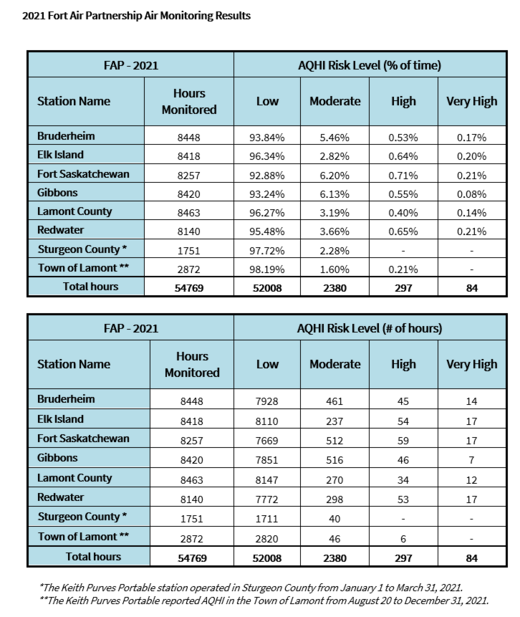Heartland Air Monitoring Partnership - Annual Air Monitoring Results
The Heartland Air Monitoring Partnership provides Air Quality Health Index (AQHI) information for Lamont County and surrounding communities. It monitors air quality within a 4,500 square kilometer airshed located immediately north and east of Edmonton. It also monitors air quality daily, providing reports and updates on its website (and in social media starting in 2022).
Heartland Air Monitoring Partnership Marks 25 Years of Grassroots Air Quality Monitoring in Alberta’s Industrial Heartland
| 2021 | 2022 | 2023 | 2024 | 2025 |
| 2021 Air Quality Monitoring Statistics | ||||
| 2022 Annual Air Quality Report (Alberta Airsheds Council) | ||||
| 2022 Air Quality Annual Report to the Community | 2024 Air Quality Monitoring Statistics (Q3) | 2025 Air Quality Monitoring Statistics (Q3) | ||
| 2022 AQHI 2018-22 Air Quality | 2024 Air Quality Monitoring Statistics (Q4) | |||
| Fort Air Partnership 2022 Annual Report to the Community |
2023 Air Quality Monitoring Statistics (annual) 2023 Annual Air Quality Monitoring (annual - impacted by wildfire smoke) |
2024 Air Quality Monitoring Statistics (annual) 2024 Air Quality Report to the Community (annual report) |
|
- Longer-Term Air Quality Trends in the Heartland.
- Fort Air Partnership Fine Particulate Matter Speciation Study News Release April 28 2022.
- What Causes Higher Risk Air Quality Ratings in Winter?
Wildfire smoke was by far the most frequent contributor to high risk and very high risk AQHI ratings measured at Fort Air Partnership’s monitoring stations in 2021. While the low risk AQHI ratings remained fairly static from 2020, the number of hours experienced with high risk and very high risk AQHI increased from the previous year.
In 2021, there were 297 hours of high risk and 84 hours of very high risk AQHI ratings. These hours were spread relatively evenly across FAP’s continuous monitoring stations, illustrating the regional effect of wildfire smoke across the Airshed in July and October. By comparison, in 2020, there were only 16 hours of high risk and no hours of very high risk AQHI ratings. (Wildfire smoke was minimal in the FAP Airshed in 2020.)
In 2021, there were 473 occurrences across FAP’s ten monitoring stations where air quality measurements exceeded Alberta’s Ambient Air Quality Objectives. This is compared to 33 exceedances in 2020. 94% of the exceedances that occurred in 2021 were due to increased levels of fine particulate matter from wildfire smoke.

